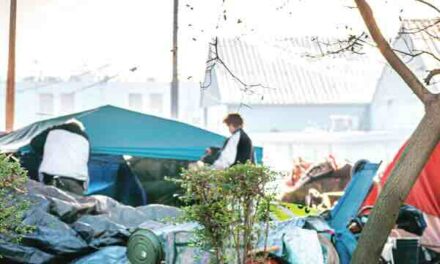Lost among the election reports was some of the best national economic news ever. The October federal employment report showed 906,000 jobs were added in the private sector, with an increase of 724,000 jobs to the labor force. Wages were up 4.5 percent. Unemployment dropped dramatically across every demographic group.
The federal government said the gross domestic product—the measure of total economic output—grew by a record-setting 7.4 percent between July and September, or 33.1 percent on an annualized basis. The economy grew at a pace never seen before. This is what economists call a V-shaped recovery.
Locally, the news isn’t so rosy. Sacramento’s recovery is on pace with our state, which trails the national economy. As a whole, California’s economy has been hit harder than elsewhere. Unemployment soared to 16.4 percent early in the pandemic before falling to 11 percent in late September. The national rate hit 14.7 percent, but now has fallen to 6.9 percent, well below California’s rate.
Several economic reports confirm the anecdotal evidence: California’s recovery from coronavirus shutdowns will be a long and difficult process—much slower than the recoveries taking place in other states.
The only state worse than California is New York. California’s peculiar mix of industries contributed to its woes. Not surprisingly, the slowdown hit some of our industries particularly hard, with arts, entertainment, recreation, tourism, food services and other retail sectors facing the most trouble.
When the coronavirus closures began in March, the national economy was enjoying record growth and vitality. Many local small businesses were on track for healthy growth and profitability.
We are now nine months into a public health crisis that forced thousands of local restaurants, shops, entertainment venues and other businesses to close down. Many have reopened, at least partially, as coronavirus restrictions eased and the economy perked up.

But others remain shuttered, many permanently—and fewer than half of the 151,000 area residents who lost their jobs during the first wave of furloughs are working again. The area’s unemployment rate, which peaked at 14 percent, is at 8.9 percent.
Economists note the failure by Congress to pass another stimulus package has taken steam out of the California economy. Hopefully, something will work out to help those who are hurting.
Whether winter coronavirus cases increase or not, the media seem to insist on predicting the worst of every potential scenario. I’ve heard the media referred to as peddling “pandemic panic porn,” and that sounds about right if you follow rational voices and opinions other than what mainstream media present. Even if the worst scenarios don’t occur, damage to the economy based upon stoking public fear is almost as bad. Let’s hope the positive news of a viable and effective vaccine helps turn around public perceptions of safety going into the New Year.
The holiday season is critical for a variety of small business folks. Retail shopping for gifts and home purchases always rises at year’s end. But restaurants, bars and food suppliers also depend on increases in family, friends and business gatherings at the holidays. After a horrible year, there is little hope these sectors will end in better shape. Early 2021 will likely be a time of reckoning for many locally owned establishments.
Another factor darkening the economic forecast: With coronavirus infection rates rising again, another shutdown could very well occur just when shops are supposed to start bustling with shoppers. Although California’s COVID-19 numbers have stayed fairly low in recent weeks, several counties in the Sacramento area have seen worrisome increases. In mid-November new restrictions were announced for Sacramento and Yolo counties that discontinued many indoor activities, including dining at restaurants. This will be a serious blow as outdoor venues are closed by winter weather.
Locally, business organizations and districts have fought back and petitioned the state to reconsider the dining closures. I wish I was hopeful the state might listen to the concerns of the economic sector.
Hair, skin and nail salons are fairing poorly. While they were among the last businesses to reopen, customers haven’t necessarily responded.
And this makes obvious the fact that local shutdowns punished some industries more than others. Job losses have been concentrated among lower-income occupations and services where working from home is not possible. California has some of the country’s worst economic disparities. This burden is especially heartbreaking and hard to reverse.
Many of Sacramento’s neighborhood restaurants and retailers are struggling to make ends meet. In a cruel twist, digital sales by giants such as Amazon soared—further crippling the little guy’s ability to compete.
Unless those of us who are able to contribute to the local economy get out and spend in every sector, we are in for serious trouble for 2021. Many caring folks I know understand what is at risk by losing neighborhood businesses. They are purposely stepping up their spending on local dining and shopping.

Yes, I’ve painted a dire picture, but it comes from my experience working with hundreds of small businesses over the years. Folks who have never been in business don’t always understand the pain and loss our neighborhood business owners are going through. It’s easy to overstate the ease of small businesses “bouncing back” if you’ve never signed a paycheck, laid off an employee or faced uncertain prospects.
I just finished reading a terrific book called “Loserthink” by Scott Adams, creator of the Dilbert comic strip. The book caused me to rethink how I think. Adams explains how untrained brains and sneaky mental habits are ruining the world.
The chapter “Thinking Like An Economist” tackles the fallacy of most predications. He says a terrible way to predict the future is to assume things will keep going the same way. And yet we do it all the time. A better approach is to anticipate surprises, understanding that it’s difficult to predict what those surprises might be.
Focusing on this way of thinking helped me cope with the heartbreaking reality of the pandemic. Looking down the road, I’ll admit at times it’s hard to see a strong path forward for our community.
Facing difficulties and challenges often heightens our creativity, drive and ability to survive. The long-term success of many of the wonderful small businesses owners and entrepreneurs I know may have much rosier futures than we might expect today.
And the possibility of new economic activity also looks promising. Sacramento was the most popular destination with home buyers shopping outside their own metro area in the third quarter of this year, according to real estate brokerage Redfin.
Everything depends on neighbors supporting local businesses and making the effort to safely venture out of hibernation. That’s the call to action with the “Pledge 100% Local” campaign we created last spring. It’s more important now than ever.
SUPPORT INSIDE
Please sign up for our Inside Sacramento weekly newsletter with even more local news than we deliver in print. Also, consider an Inside membership starting at $19.95 a year. Visit insidesacramento.com/shop.
Cecily Hastings can be reached at publisher@insidesacramento.com. Follow us on Facebook, Twitter or Instagram: @insidesacramento.com.














